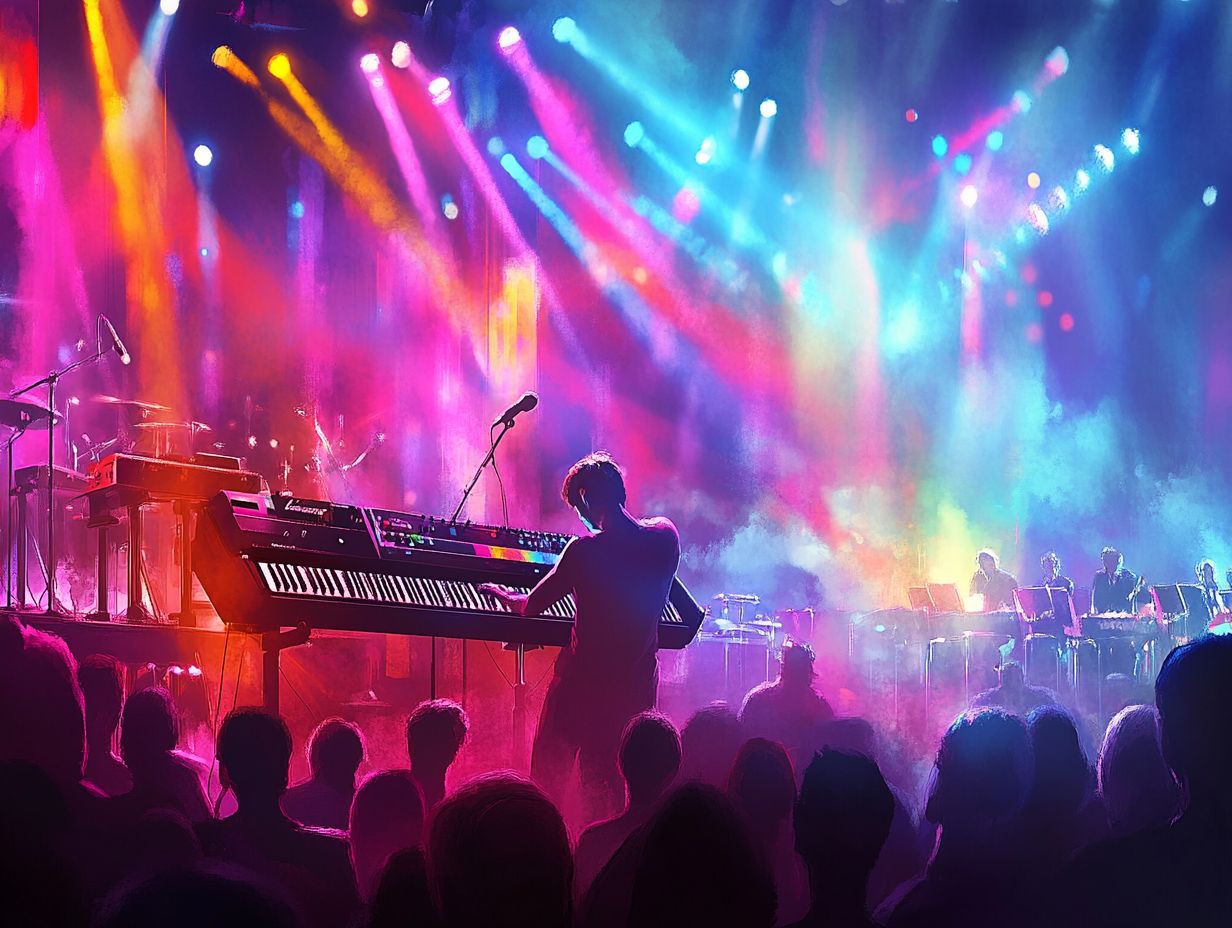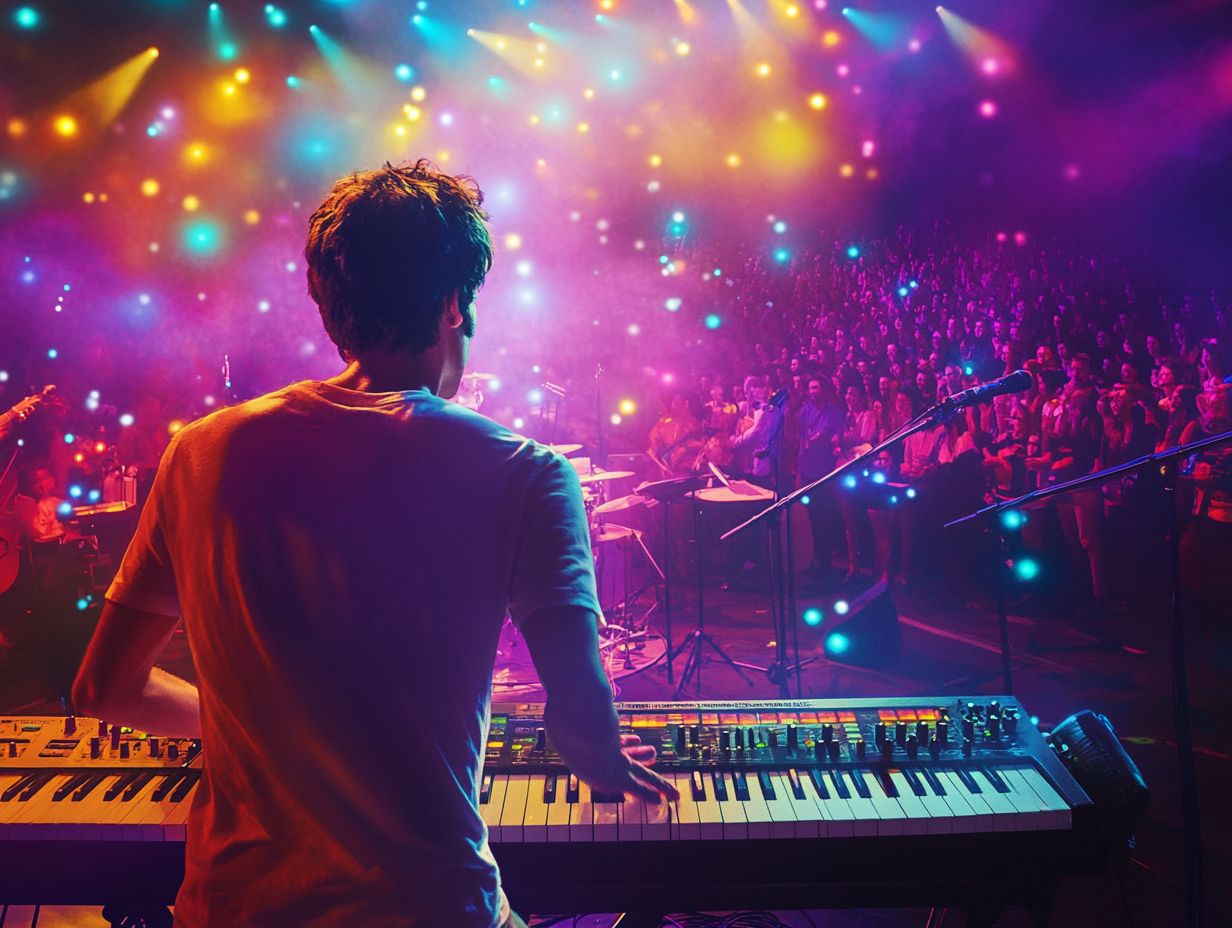Keyboards have played a pivotal role in shaping the sound of music across various genres and eras, evolving from humble beginnings into essential instruments in both popular and classical settings.
This article explores the fascinating journey of keyboard instruments, beginning with their early iterations and their integration into popular music.
It highlights their significant contributions to both rock bands and orchestras, showcasing renowned keyboardists and the diverse roles keyboards occupy in genres such as jazz, pop, and electronic music.
Join us as we uncover the rich history and enduring influence of keyboards in the world of music.
Contents
The Evolution of Keyboards in Music

The evolution of keyboards in music showcases the extensive innovation and creativity that have influenced their development over centuries and shaped the creation and performance of various music genres, including classical music, jazz, and pop.
From early keyboard instruments such as the harpsichord and organ to modern synthesizers, the adaptability of keyboards has played a fundamental role in music composition and sound design. As these instruments evolved and became integrated into orchestras as well as rock and pop bands, they transformed into essential tools for shaping musical dynamics, facilitating diverse emotional connections through harmony, melody, and rhythm.
Early Keyboard Instruments
Early keyboard instruments, such as the harpsichord and organ, laid the foundational groundwork for modern keyboard technology and significantly influenced composers and musicians throughout music history, particularly in the classical genre. Their distinctive soundscapes, along with their timbre and musical versatility, offered opportunities for complex arrangements and enriched live performances.
The construction of these instruments demanded precise craftsmanship; the harpsichord produces sound by plucking strings, while the organ generates sound through a series of pipes or electronic means. Their unique qualities attracted the attention of master composers like Johann Sebastian Bach and Domenico Scarlatti, who explored their potential in innovative compositions that pushed the boundaries of contemporary music theory.
The evolution of keyboard instruments marked a pivotal turning point, allowing composers to experiment with harmony, counterpoint, and texture, ultimately leading to more complex works that defined their legacies and shaped the future of Western classical music.
Incorporation into Popular Music
The incorporation of keyboards into popular music has revolutionized the sound across genres, from pop to rock, making synthesizers essential components in music production and songwriting. This integration has expanded the sonic palette available to musicians while redefining audience engagement by enhancing emotional connections through various musical dynamics.
Keyboards have become vital instruments for countless artists, enabling them to explore new textures and atmospheres, as exemplified in iconic albums such as Pink Floyd’s “The Dark Side of the Moon” and Fleetwood Mac’s “Rumours.” These albums feature keyboardists who skillfully weave layers of sound, elevating the music to new heights.
Memorable live performances by artists like Elton John and Stevie Wonder demonstrate how keyboard players can captivate audiences, creating a visual and auditory experience that deepens the relationship between the artist and their fans. Moreover, the presence of keyboards in a band’s dynamic not only supports instrumental harmony but often conveys the emotional essence of the songs.
The Role of Keyboards in Rock Bands

Keyboards have become an essential element in rock bands, playing a significant role in shaping the overall sound and dynamics of both live performances and studio recordings.
From the iconic riffs produced by electric pianos to the atmospheric layers created by synthesizers, the versatility of keyboards enables bands to explore a diverse array of music genres and styles.
This versatility enhances their artistic expression and fosters greater audience engagement during performances.
Key Contributions to the Sound
Keyboards play a crucial role in the sound of rock music by providing essential layers of harmony, melody, and rhythm that contribute to a band’s identity. The instrumental techniques employed by keyboardists create unique soundscapes that blend various musical styles and enhance the overall musical arrangement.
Organ fills add a rich, textured depth to tracks and are prominently featured in The Doors’ “Light My Fire,” where the distinctive sound of the Hammond organ has become one of the most recognizable and beloved sounds in rock music.
Synthesizer leads have also left a significant mark on rock history, with memorable riffs in songs like Yes’s “Roundabout” serving as prime examples.
Piano solos convey powerful emotional depth, as demonstrated in Elton John’s “Rocket Man.” These elements of rock music not only highlight the genre’s signature sound but also elevate the artistry of each individual composition.
Famous Keyboardists in Rock Music
Renowned keyboardists in rock music have demonstrated their virtuosity and left a lasting impact on the genre with their unique styles and dynamic stage presence. Artists such as Elton John, Jon Lord, and Rick Wakeman have elevated the keyboard’s role, transforming it into a lead instrument that shapes the creative direction of their bands.
These musicians possess an extraordinary ability to blend technical skill with emotional depth, crafting unforgettable melodies and harmonies that resonate with fans. For example, Elton John’s flamboyant performances and heartfelt ballads have not only redefined pop rock but have also inspired countless musicians.
Similarly, Jon Lord’s innovative use of the Hammond organ in Deep Purple’s heavy sound has redefined the boundaries of rock music. Rick Wakeman, known for his elaborate arrangements and theatrical live shows, has infused progressive rock with a distinctive flair, making each performance a captivating experience.
Collectively, these keyboardists have made significant contributions to the rich tapestry of rock music, influencing both their contemporaries and future generations.
The Role of Keyboards in Orchestras

Keyboards play a crucial role in orchestras by bridging traditional acoustic instruments with contemporary sound design. Instruments such as the concert grand piano and organ contribute rich textures and layers to classical music compositions, enhancing musical dynamics and overall ensemble performance.
Additionally, they facilitate creative arrangements, allowing for a more versatile musical experience.
From Harpsichords to Concert Grand Pianos
The transition from harpsichords to concert grand pianos represents a significant milestone in the evolution of keyboard instruments within orchestras, reflecting the evolving musical tastes and technological advancements throughout music history. This shift has provided greater expressive capabilities, allowing composers to explore a broader range of emotions through their musical interpretations.
The harpsichord, known for its plucked strings, produced a distinct and bright tone that defined the Renaissance and Baroque periods, often associated with composers such as Johann Sebastian Bach and François Couperin. As the Classical era emerged, the need for a greater dynamic range led to the development of the fortepiano, a precursor to the modern piano that offered both soft and loud dynamics.
Influential composers like Mozart and Beethoven began to harness the fortepiano’s capabilities, expanding the boundaries of musical expression. The subsequent invention of the concert grand piano, with its larger size and refined action, further enhanced the instrument’s versatility, enabling intricate performances in orchestral settings and shaping the future of classical music.
Key Functions in Classical Music
Keyboards play a vital role in classical music by providing accompaniment, harmonic support, and fulfilling various functions within orchestras. They help create a range of timbres and dynamics that enhance ensemble playing.
In terms of melody, keyboards contribute by adding counter-melodies, which enrich the complexity of the melodic material. Instruments like the piano and harpsichord excel in producing multiple voices simultaneously.
Harmonically, the rhythmic and melodic support from these instruments creates a solid backdrop for the ensemble’s musical ideas, offering both rhythmic structure and stability in the overall tempo, which helps build tension and facilitate release throughout the piece.
In orchestral contexts, the interaction between various string and woodwind instruments becomes especially prominent with the inclusion of percussive or harmonic instruments like the piano or harpsichord, which significantly contribute to the dynamics and overall texture of the music.
The Influence of Keyboards on Music Genres

Keyboards have significantly influenced various music genres, including jazz, pop, and electronic music, by shaping their distinctive sounds through innovative use and the blending of genres.
This instrument has enabled musicians to experiment with different textures and rhythms, ultimately enhancing the artistic expression and emotional depth of their creations.
Impact on Jazz, Pop, and Electronic Music
Keyboards play a crucial role in jazz, pop, and electronic music, serving as powerful instruments that facilitate improvisation, unique sound production, and creative arrangements that define these genres.
In jazz, the piano is a traditional instrument commonly used in bands, while synthesizers are frequently embraced by electronic jazz musicians. The versatility of the piano allows for instant creation and experimentation with melodies, harmonies, and rhythms, making it essential in the improvisational nature of jazz. Various types of keyboards, including electric pianos like the Fender Rhodes and Wurlitzer, are utilized for jazz improvisation.
Renowned jazz keyboardists such as Herbie Hancock, Chick Corea, and Robert Glasper are known for pushing the boundaries of improvisation by blending jazz elements with funk and rock influences. Jazz performances often feature extended solos that showcase spontaneous improvisation, a hallmark of the genre. Hancock, in particular, is celebrated for his impromptu solos that reflect the diverse genres he has explored throughout his career, while the band’s interaction with the audience enhances the immersive experience.
Similarly, Corea frequently collaborates with musicians from various genres, including flamenco, jazz, and rhythm and blues, incorporating improvisational solos into his performances. Modern jazz keyboardist Glasper is recognized for his ability to merge jazz with hip-hop and R&B.
In pop music, the piano has long been a dominant instrument for composing and performing songs. Keyboardists have been instrumental in shaping modern pop music since the mid-20th century, with artists like Elton John and Billy Joel standing out for their piano-centric music.
Elton John, influenced by The Beatles, began composing songs on the piano and later expanded his sound by incorporating a full band. His iconic tracks, such as “Rocket Man” and “Goodbye Yellow Brick Road”, prominently feature the piano. Billy Joel, known for his musical diversity, often draws inspiration from classical compositions to craft his piano-based songs, characterized by memorable melodies that have become enduring hits.
Joel’s timeless music continues to resonate with audiences worldwide as he tours globally.
In the realm of electronic music, pioneers like Jean Michel Jarre and Daft Punk are celebrated for their innovative use of keyboards in shaping electronic sound. Jarre, an early advocate of synthesizer-based music, is known for integrating synthesizers with other instruments such as keyboards, drum machines, and samplers. His elaborate outdoor performances often feature a wide array of audiovisual effects.
Daft Punk is renowned for their unique fusion of house music with disco, funk, and rock, utilizing a diverse range of instruments, with the keyboard playing a central role. Both Jarre and Daft Punk are recognized for their distinctive studio techniques that create rich and complex sound arrangements.
Blending Classical and Modern Styles
Keyboard instruments are increasingly being utilized to blend classical and modern styles, giving rise to new genres and expanding the horizons of musical expression and innovation. This evolution highlights the versatility of keyboards, as they connect traditional techniques with contemporary sound design, offering limitless opportunities for both composers and performers.
Notable artists in this field, such as Ludovico Einaudi and Ólafur Arnalds, exemplify this fusion in their work by using classical motifs as a foundation for further exploration through electronic and soundscape elements. By incorporating synthesizers, sampled sounds, and advanced effects, they create compositions that reflect the complexities of modern society while also honoring the timelessness of classical music.
Additionally, keyboard technology is rapidly advancing, with instruments like digital pianos and workstations providing unprecedented flexibility in sound manipulation, thereby give the power toing a new generation of artists to experiment and explore novel avenues.
